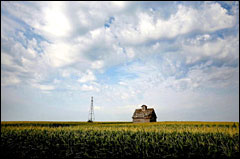When I arrived in Iowa on a reporting trip this summer, I expected to experience it with city eyes: frankly, as a rural backwater. I’ve lived on a farm in the Appalachians of North Carolina since 2004, but the ten years before that, I lived in Mexico City and New York City. I don’t know from vast fields and wide horizons.
Instead, barreling down the highway between appointments across the state, surrounded on all sides by expanses of corn and soy, my progress through space marked by that little hypnotic line that forms as your eye picks up the gaps between rows, what I thought was: what a triumph of science.
Iowa, a miracle of science.
Photo: Mark Hirsch
White settlers fleeing the already-overdeveloped East Coast showed up here in the 1850s and found marshlands and prairie, with grasses that towered over their heads. From that to this in 150 years: trillions upon trillions of plants from just two species, packed as close together as city commuters on the subway at rush hour, but much more orderly. Not a weed in sight, unless you count the forlorn prairie-grass remnants that line the roadside, awaiting the mower’s blade.
My travels around the state drove home the full extent to which industrial agriculture has conquered Iowa. The whole package: hybridized and now genetically modified seeds; insecticides and herbicides; great climate-controlled towering machines called combines from whose lofty heights a single person can manage a thousand acres and more; and feedlots where livestock get stuffed together like corn plants so they can be fed corn.
I thought: These fields are as impressive and brutal as any example I’ve seen of humanity’s will to transform landscapes to its whims — as impressive as the Manhattan skyline, or the view of the valley occupied by Mexico City that you get from an airplane.
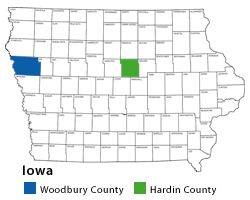
And industrial agriculture is still tightening its grip over the land. Confined-animal feeding operations, or CAFOs, are “expanding at a steady and deliberate rate,” declares a recent report [PDF] from Iowa State University; the 2007 hog herd is 5 percent bigger than last year’s. And corn and soy, the crops that cover two-thirds of Iowa’s soil and keep the CAFO system humming, are doing just fine. Corn farmers are enjoying prices at 10-year highs as they bring in their “bin-busting” harvest. Soy farmers, too, are experiencing the sweet confluence of high prices and solid yields.
Yet the logic of industrial agriculture has by no means conquered all hearts and minds in Iowa. I found plenty of people who are fighting back — although they get little support from Iowa’s politicians. And in small pockets scattered across the state, I found others organizing to reject industrial agriculture wholesale and reclaim Iowa’s soil as a tool of local development. Here’s a taste of what I saw, embodied in two very different places.
Hogging the Spotlight
At first glance, Hardin County, located in the central part of the state an hour north of Des Moines, is just another rural county. It’s blanketed in corn and soy, and houses what’s become the sine qua non of rural Iowa: an ethanol plant. But Hardin isn’t just another rural county: it’s arguably the state’s CAFO capital. Its only rival for that title, Sioux County in the northwest, occupies a larger land mass (739 square miles vs. 570 square miles), meaning Hardin has a greater hog density per area. The county’s farmers have kept hogs for as long as anyone can remember, but CAFOs didn’t start popping up until the early 1990s.
I drove through the area with three farmers who have been fighting the CAFO explosion. As we moved along country roads, every few miles a set of low-slung buildings would break through the monotony of corn and soy fields. Sometimes there would be two together; sometimes as many as six or eight lined up in two rows. You can’t just walk up to a hog confinement and look inside. CAFO operators are justly terrified that a trespasser could infect the hogs; animals raised this way have little in the way of immune systems. So the lawns in front of most CAFOs display “no trespassing” signs.
Each building, I learned, houses around 2,500 pigs. Often, a kind of big black pond separates the rows. The CAFO industry favors the word “lagoon” to describe these open repositories of feces and urine; I prefer “cesspool.” Newer CAFOs, I learned, can no longer utilize open cesspools. So they plunk the confinement building on top of the cesspool: 2,500 hogs standing over their own several-months’ accumulation of waste.
The smell emanating from these operations is impressive, a kind of deep, penetrating, putrid stench that told my body one thing: get away. Minutes into the tour, my eyes were burning. With an hour or two, I felt queasy.
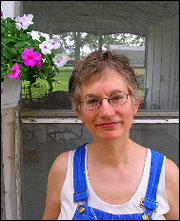
Marian Kuper.
Photo: Mark Hirsch
Marian Kuper, one of the farmers on the tour, told me how hog confinements first hit home for her.
Back in 1993, she and her husband had just moved to Hardin County to launch a grain farm. They had met as students at Iowa State University in nearby Ames. His family had farmed in Hardin for generations.
When they arrived, hogs were still part of a relatively diversified agricultural landscape. Grain farmers typically kept a few hundred pigs as an extra cash crop. But CAFOs were starting to sprout up — and Kuper’s father-in-law was considering selling 10 acres to a man who wanted to install a confinement house.
The tract in question sat too close for comfort to Kuper’s home. “I didn’t know much about CAFOs at the time,” she says. “I just knew they smelled bad, and didn’t feel like living next to one.” So Kuper started lobbying her father-in-law not to sell the tract. As he wavered, the buyer kept sweetening the offer.
To gain ammunition for her argument against the CAFO, Kuper went to the Hardin County Courthouse to dig through property records and see what she could find out about the would-be buyer, a man named Jeff Hanson who had just launched a hog-raising business called Iowa Select Farms, centered in Hardin’s county seat, Iowa Falls.
“I didn’t really find out much at all,” she says. “But Hanson must have heard that I was poking around, because he angrily rescinded his offer, and put the CAFO somewhere else.” Kuper’s father-in-law became furious with her “meddling,” and a family rift opened up. Kuper’s in-laws refused to speak to her for two years, even though the couples lived just miles apart.
“I later learned it was happening all over the county,” she says. Family tensions over hog confinements were spilling into open conflict.
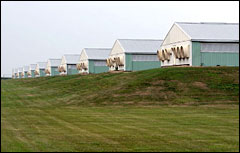
A Hardin County hog CAFO
Photo: Mark Hirsch
Things have changed in Hardin County since Kuper’s family spat 14 years ago. On a positive note, she gets along just fine with her in-laws now. But that’s because the intense concentration of hogs has wreaked havoc on the quality of life in Hardin, degrading streams with manure runoff and periodically filling the air with that putrid stench. “They understand my point of view now,” she says.
Over the past 15 years, hog production has concentrated into fewer and fewer counties in Iowa even as it expanded, putting severe pressure on the people who live in CAFO-dominated areas. “From a high spot on our land, we can see a good 100 hog operations within a four-mile radius,” says Kuper, who along with her husband runs a 250-acre grain farm and raises beef cattle on pasture.
According to Iowa State University research, 337 farms in Hardin County kept hogs in 1992. By 2002, that number had dropped to 137. Essentially, the diversified farms stopped raising hogs over that period.
But while the number of hog operations dropped, the total number of hogs skyrocketed, from around 200,000 to nearly 900,000. Kuper figures that since 2002, the last year for which figures are available, the number of hogs confined in Hardin annually has grown even more, surpassing a million. That means nearly 55 hogs for each one of the county’s 18,000 residents. And it’s a sizeable chunk of the 15.5 million hogs raised each year in the nation’s No. 1 hog-producing state.
A report [PDF] from the Washington-based Environmental Integrity Project documents the environmental and human-health damage caused by intense concentration of CAFOs. The report claims that between 1992 and 2002, the state of Iowa counted nine manure spills in Hardin — fourth-most of any county. The report also shows that because of lax oversight, the state severely undercounts manure spills.
Today, Iowa Select Farms, the fledgling enterprise that nearly bought property from Kuper’s father-in-law in 1993, has become the fourth-biggest hog producer in the United States. Kuper and her fellow Hardin County activists have some outside allies in the fight against Iowa Select and the other corporations doing business in their back yard — like the scrappy Des Moines-based Iowa Citizens for Community Improvement — but theirs is a long uphill slog.
CCI has been leading a lobbying effort for what’s known as “local control” — the right of counties to create their own CAFO standards. Currently, the state of Iowa regulates issues like how far CAFOs can be from residential houses — and the CAFO explosion experienced by Hardin County generally occurred within the bounds of Iowa code.
“The Iowa codes are ridiculously lax, and the CAFO industry just picks and chooses which counties to stuff a bunch of CAFOs,” says Tyler Reedy, who left a post as community organizer for CCI recently to run for a spot in the Iowa legislature. “Local control is about giving counties the power to say no.” Reedy says that statewide polls have for years consistently shown majority support for local control, but proposals typically die in the state legislature, regardless of whether Republicans or Democrats control it. “The meat industry just has a lot of money to throw at politicians.”
Another way state government seems to fail the citizens of Hardin and other CAFO-dominated counties is by not enforcing the national Clean Water Act. Currently, the EPA charges the Iowa Department of Natural Resources with making sure CAFOs comply with federal water rules. But the above-mentioned Environmental Integrity Program report documents the myriad ways the Iowa DNR has betrayed the state’s citizens in this regard.
Essentially abandoned by the government agencies that exist to protect their rights, Marian Kuper and her allies have so far only been able to watch the CAFO takeover with disgust. Meanwhile, the place they call home is essentially being used as a waste trap by the hog industry. “After years of calling politicians, signing petitions, demonstrating in Des Moines, writing letters to the editor, and organizing meetings, you just keep watching these CAFOs pop up,” she says. “You end up discouraged, angry, and upset. But we live here, and we’re not giving up.”
Woodbury at Work
Click here for an audio slide show of the Floyd Boulevard revolution.
Another Way
Woodbury County seems an unlikely candidate for a budding revolt against industrial farming. Vast fields of corn and soy surround the county seat, the small industrial city of Sioux City (pop. 83,000). The town’s main industry is meatpacking: Smithfield and Tyson, the world’s two largest meat producers, both run plants there. Grain-buying giant Archer Daniels runs a livestock-feed processing plant in Sioux City, too. Just 40 miles north of Woodbury, in the northwest corner of the state, lies Sioux County, home to around 1 million confined hogs — and Hardin County’s only rival as Iowa’s pigshit capital.
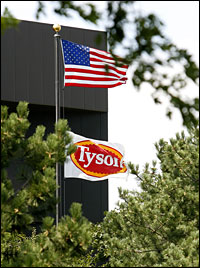
Land of the free, and home of the crave.
Photo: Mark Hirsch
Yet right in the middle of this hub of industrial agriculture, citizens have organized to construct one of the nation’s most innovative and effective local foods programs. Their successful effort lies half a state — and a world away — from Hardin County.
Woodbury County had been making waves in sustainable-ag circles for a couple of years because of its innovative pro-local food policies. I went there a few days after the Hardin visit hoping to see a different way. What I found is one of the most advanced and effective local-food programs I’ve seen anywhere in the country.
Right downtown, amid the vague odor of a hot-dog factory run by Smithfield, I found the Floyd Boulevard Local Foods Market. After days of stark corn views and an industrial-food diet, it was a revelation. The market, I found out, runs a twice-weekly farmers’ market, a store featuring local pastured meat as well as health-food grocery staples, a brokerage that sells produce to nearby restaurants and retailers, and a restaurant. The brilliant part is that all of it — the entire infrastructure — is owned by farmers who live nearby. The business model is nothing short of revolutionary.
Instead of relying on the typical system — in which a “successful” farmer runs 1,000 acres in corn and soy, hopes for a good price from the market, relies on government subsidies to make up the difference, and is at the mercy of big grain processors and meat producers that buy all that corn and soy cheap and then sell it dear in the form of meat, sweeteners, food additives, and increasingly, biofuel — the Floyd Boulevard model subverts all that.
Farmers retain the value of the produce at every possible stage — in the case of the restaurant, all the way from farm to fork. And they’re marketing to a customer base that wants quality, variety, and assurances of responsible land stewardship. The money generated — about $30,000 a week by the restaurant, store, and brokerage during the growing season, with farmers’ market vendors bringing in another $25,000 to $30,000 each week — stays within the community, rippling through the economy and creating wealth.
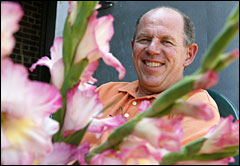
Pat Garrity.
Photo: Mark Hirsch
According to Pat Garrity, a veteran fruit-farmer-turned-general-manager of the market, it took an extraordinary amount of community organizing and fundraising to make this project a reality. That’s no surprise — rebuilding local-food networks in a way that’s sustainable for farmers requires an investment in infrastructure. Farming simply doesn’t generate sufficient profits to make such investments.
The Floyd Boulevard project started in 2004. At the time, Sioux City had a core of people who wanted local foods, as well as several nearby farmers who wanted to supply them, but no robust network to connect them. “People were driving clear over to Omaha [Nebraska] and Des Moines to find local foods,” Garrity says. At the same time, he says, an active local chapter of the U.S. Humane Society was working to improve the sad lot of farm animals — a quixotic task in the land of CAFOs and industrial slaughterhouses.
Meanwhile, a local real-estate developer named Cliff Tufty bought an abandoned warehouse in downtown Sioux City and wanted to use it for an economic-development project — and was willing to let the right project use the space rent-free while it got off the ground. Led by a few farmers and local-food enthusiasts, the project launched with a $54,000 grant from the Humane Society, designed to encourage farm-animal stewardship by creating a market for pastured meat. The Waitt Foundation — the philanthropy arm of Gateway computer, which has a presence just across the border in South Dakota — contributed another $50,000.
From that seed capital sprang the Floyd Boulevard Local Foods Market. Initially, the group opened the local-meat shop in the warehouse and established a twice-weekly farmers’ market just outside. In contrast to previous farmers’-market efforts in the town, this one was well organized — mainly because there were resources to hire a market manager, a role that had always been taken by volunteers or busy farmers, Garrity says.

Dinner at the Firehouse Bistro.
Photo: Mark Hirsch
Then the angelic real-estate developer, Tufty, bought an old, out-of-use Sioux City firehouse next door to the warehouse. More fundraising, as well as an institutional makeover, led to the launch of the Firehouse Bistro in 2006, a full-service restaurant that transforms the bounty from nearby farms into delicious fare. Another critical piece fell into place in 2006 when the for-profit side of the project launched a brokerage designed to sell produce to outside entities. The brokerage is currently selling a significant amount of food to the Whole Foods in Omaha, Neb., about 100 miles south.
The project never would have gotten off the ground without outside cash, Garrity says. The other “absolutely critical” aspect, he adds, is community support. Before taking the leadership role at Floyd Boulevard in 2006, Garrity ran a mid-sized organic fruit farm in South Dakota that sold its produce in a variety of farmers’ markets throughout the area. He started running a stand at the Floyd Boulevard Market in 2004. “I’d never seen the level of enthusiasm and passion for local food before,” says Garrity, who started his farm in 1979. “There are people who buy so much food sometimes, you wonder if they can eat it all.”
As much as they’ve accomplished since 2004, the Floyd Boulevard folks are by no means done. They plan to expand the natural-foods store into a full grocery; install a commercial kitchen for making canned vegetables, jams, and other value-added products; and extend ownership to farmers within a 100-mile radius, whose produce they could move through the brokerage. “We’d like to be a regional hub for vegetable production, showing farmers that it’s possible to make a living growing something besides corn, soy, and confinement hogs,” Garrity says. “Down the road, I can imagine this as a multimillion-dollar business, through which plenty of small- and mid-sized farmers make a living.”
What a Difference a Government Makes
So what’s the difference? Why is Hardin County mired in hog excrement and political indifference while Woodbury County thrives? One reason is surely population density. The population of Sioux City alone dwarfs the entire population of Hardin County.
But another factor — and a key one — is the role of government. While Hardin County officials have been docile amid the CAFO onslaught, the county government in Woodbury has, by some miracle, worked hard to support the local-foods movement. The same year the Floyd Boulevard project launched, the Woodbury County Board of Supervisors started rolling out initiatives to support farmers growing for the local market.
First there was an Organics Conversion Policy, offering up to $50,000 annually in property tax rebates for farmers who go organic. Not long after, the board came out with the first Local Food Purchase Policy of any county in the nation. The act requires local departments to, when possible, buy locally grown, organic food from within a 100-mile radius for regular city use. By design, the Floyd Boulevard project’s brokerage arm will handle these sales when the program becomes operational.
According to Garrity, the gadfly who has pushed county leaders in that unlikely direction is Rob Marqusee, who serves as director of Rural Economic Development for Woodbury. Marqusee is a self-described disciple of the late urban theorist Jane Jacobs, the great champion of building robust local and regional economies in a world dominated by huge corporations.
“In the past, the county saw ‘economic development’ as bribing a corporation to set up here by handing out tax breaks,” Marqusee says. “Meanwhile, our small- and mid-sized farms are going out of business.”
He says his triumph has been to convince county policymakers that the area’s rich store of topsoil is an economic engine. “Until I came around, nobody in the county government saw promoting agriculture as a tool of economic development,” says Marqusee, a native Floridian who came to town in the late 1990s to work at Gateway and became charmed by Sioux City.
Marqusee’s next big project is to raise $2 million to give no-interest loans to help young would-be organic farmers buy land in the county. “If we’re really going to make this work, we need more young growers, and right now, land is too expensive to launch a farm,” he says. With Floyd Boulevard up and running, such farmers would have a ready marketing infrastructure for their goods, something wholly lacking in most rural areas across the U.S.
While folks in Woodbury establish new institutions and dream big, Hardin County residents are forced to play defense. At this point, just freezing CAFOs at current levels would feel like a victory. It’s possible that Woodbury’s example offers Hardin’s people a way forward: rather than battle industrial agriculture, circumvent it by doing something completely different. In fact, Marian Kuper told me that a community-supported agriculture farm has sprouted in Hardin, growing produce for neighbors to eat.
But it’s also a fact that Woodbury would not be where it is if its citizens hadn’t gained access to some $250,000 in grants. Any serious challenge to environmentally ruinous agriculture needs resources.
Whatever their differences, Hardin and Woodbury represent two visions for the future of agriculture, one dismal, one inspiring. Citizens and policymakers nationwide should study both well.
